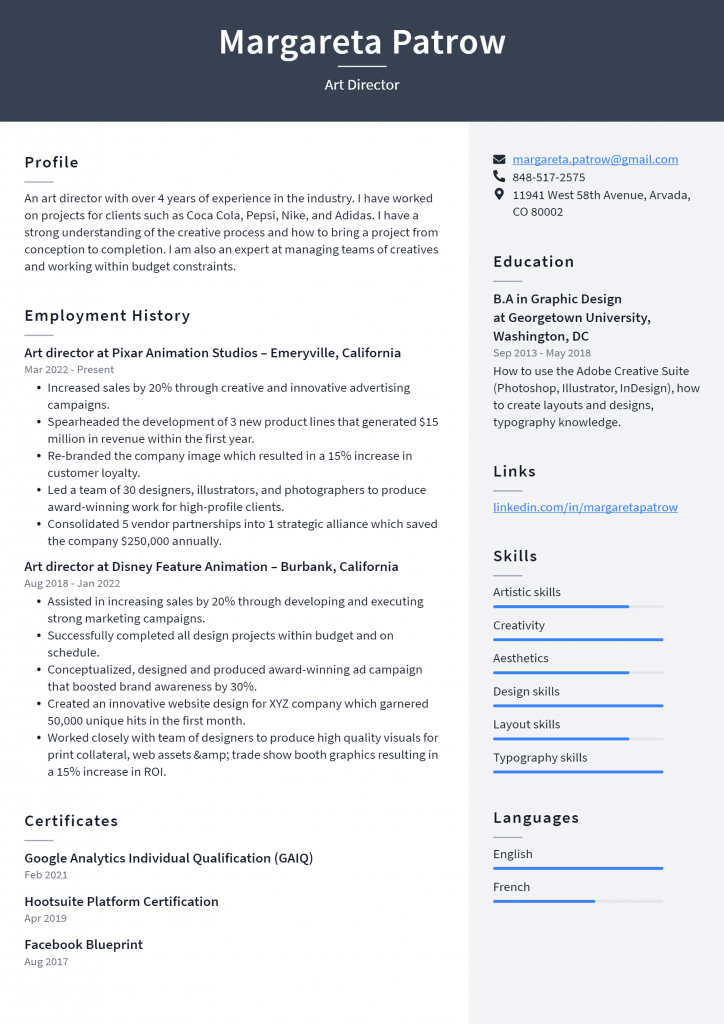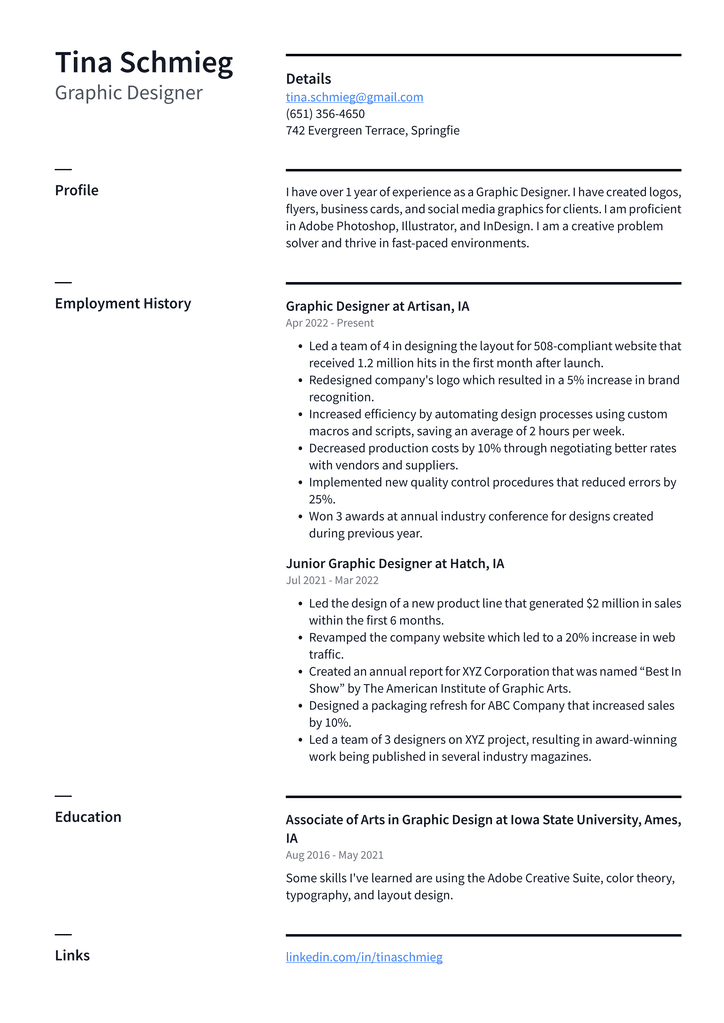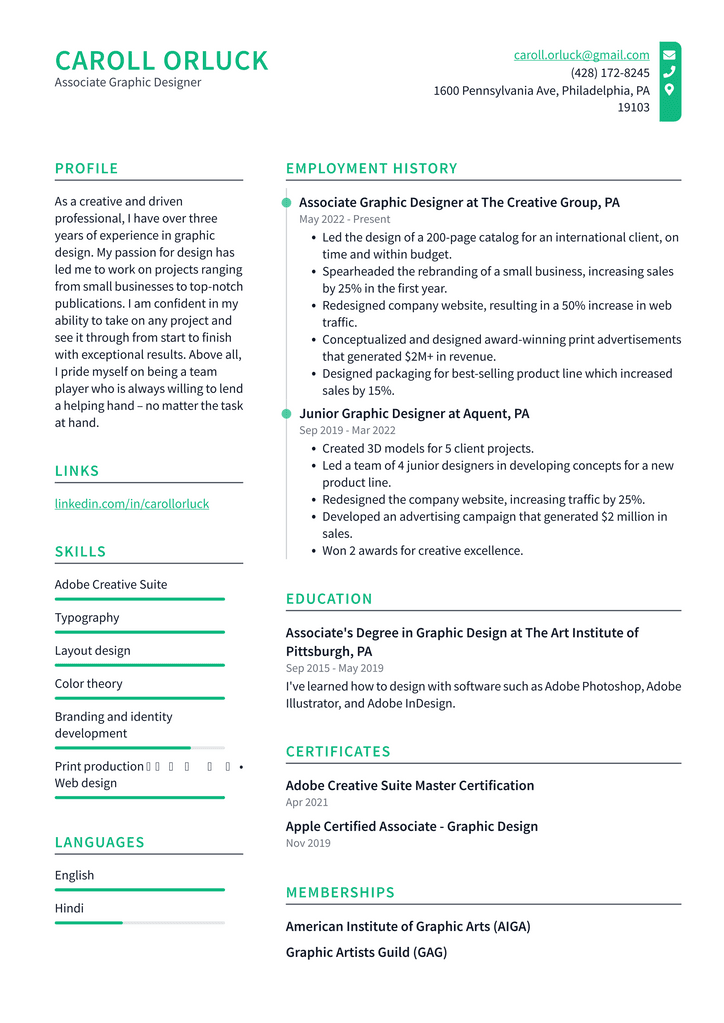Are you looking for a new job as a visual communications specialist? Do you want to emphasize your skills and experience in advertising, marketing, or communications? If so, consider creating a visual communications resume. Also known as an art director resume, this document will allow you to showcase your skills and experiences in a way that is more relevant to visual communications positions. An art director’s resume should focus on your ability to collaborate with team members, manage projects from concept through final execution, solve problems creatively, and identify issues before they become visible to the public. These are just some qualities that hiring managers look for when assessing applicants. The same is true if you’re applying for any other position that requires visual thinking and problem-solving. Let’s look at what goes into a great art director’s resume.
Art Director Resume Example

Download This Art Director Resume as PDF
Associate Art Director Resume Example

Download This Associate Art Director Resume as PDF
Senior Art Director Resume Example

Download This Senior Art Director Resume as PDF
Assistant Art Director Resume Example

Download This Assistant Art Director Resume as PDF
Senior Graphic Designer Resume Example

Download This Senior Graphic Designer Resume as PDF
Graphic Designer Resume Example

Download This Graphic Designer Resume as PDF
Associate Graphic Designer Resume Example

Download This Associate Graphic Designer Resume as PDF
Create a Great Art Director Resume
Your resume is your first opportunity to make a great impression and get noticed by hiring managers. It’s not just a list of your past accomplishments, though—it’s also a way for employers to get to know you as a professional. Here are some tips to help you create a visually-driven resume that will stand out from the crowd: – Carefully select the order of your information. Start with your most current or relevant experience, then work backward if necessary. – Make the visual elements of your resume consistent. Your text’s font, style, and color should be consistent throughout the document to create a visually cohesive resume. – Create a “visual brief.” Include a visual summary of your skills and experience, such as a flow chart or word cloud. – Use visuals whenever possible. Don’t just list facts—let them illustrate your strengths and expertise. Use graphics, charts, graphs, and other visuals to highlight your value. – Target your resume. Tailor your resume to each specific position you apply for.
Start With a Solid Foundation
An art director’s resume starts with a solid foundation. Any visual communications professional knows that a great design begins with a strong foundation. Your resume should do the same. Begin with an outline that outlines your skills, experience, and achievements. Start with a template. There are many pre-made resume templates online that you can use as a starting point. Once you have a solid outline, you can make adjustments as necessary to create a visual communications resume that truly reflects your skills and experience—narrow your focus. No matter what field you work in, some of your skills are more relevant than others. When creating your outline, focus on the skills and experience that will most benefit your career.
Showcase Your Skills
Your experience and skills are the foundation of your art director’s resume. You aim to demonstrate your abilities through your resume, highlighting your skill set and experience. Start with skills that are transferable across positions and industries. Skills like visual thinking, problem-solving, strategic planning, organization, and attention to detail are valuable across most industries. Let your skills drive the design of your resume. Let each skill go into a section of your resume. For example, if organizational skills are one of your most vital areas, you might want to start with that skill. Organizational skills could drive the introduction, while your experience and education follow.
Include Relevant Work History
Your work history section can take various forms, depending on your application. For example, suppose you’re looking for a position in advertising or communications. In that case, you may need to focus on the companies and jobs you’ve held, while an educational institution may want to see a list of your teaching experience. Depending on your field, you may be able to skip the traditional “work experience” section and include a “projects” or “publications” section instead. This works particularly well for designers and architects, and it can work for communications professionals as well.
Showcase Your Creative Projects
One of the best ways to showcase your creative side is to create a visual portfolio of your past projects. Creating a graphic portfolio is a great way to showcase your creative experience and creative approach, as well as your organizational skills and attention to detail. Your visual portfolio should include a visual summary of your projects. You may also want any relevant links to your online portfolio, such as links to your blog posts or social media pages.
Include Professional Accomplishments
Professional accomplishments demonstrate your experience and ability to attain goals, solve problems, and work collaboratively with others. If you’re applying to work in communications or advertising, you may want to include a “special skills” or “accomplishments” section in your resume. Your accomplishments could be related to projects you’ve worked on, your degree, or awards. The key is finding relevant achievements in your field, which will show hiring managers you’re the right person for the job.
Conclusion
Creating a visual communications resume highlighting your skills and experience is a great way to get noticed by hiring managers and stand out from the crowd. Your resume should start with a strong foundation, with each section building on the next. You should also showcase your skills, relevant work history, creative projects, and professional accomplishments. Your resume should be visually driven and showcase your creative side, as well as your organizational skills.